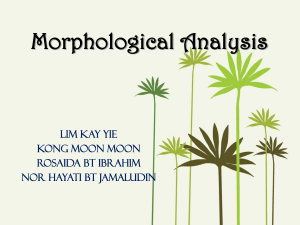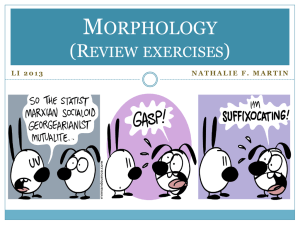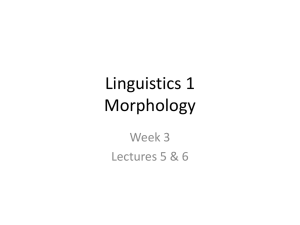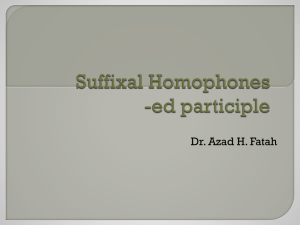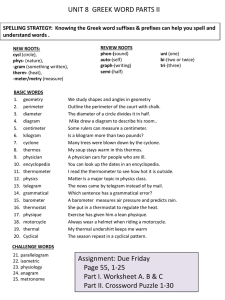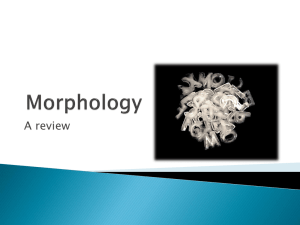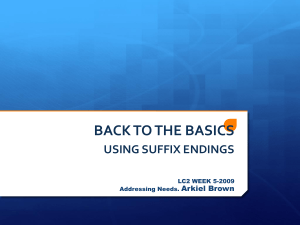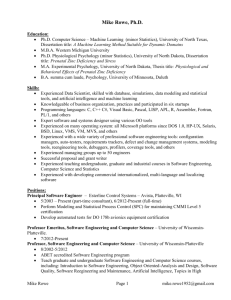Morphology (Review exercises)
advertisement
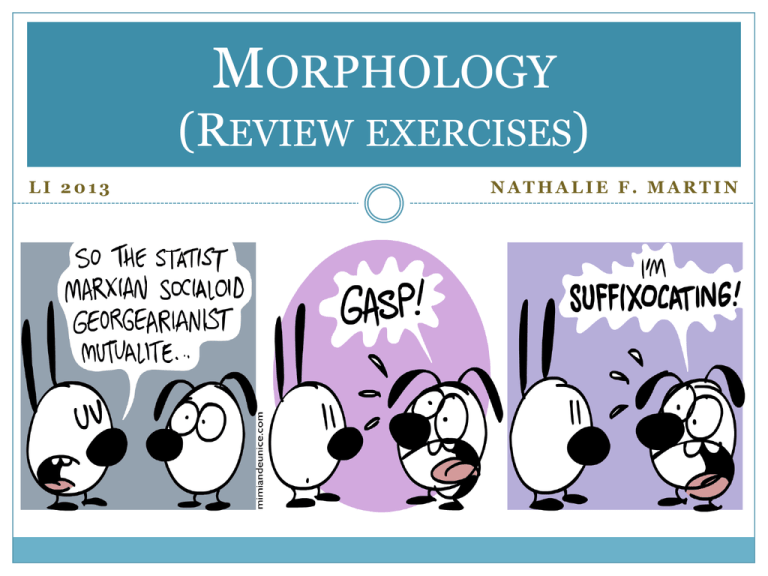
MORPHOLOGY (REVIEW EXERCISES) LI 2013 NATHALIE F. MARTIN Morphemes WORDS: SIMPLE OR COMPLEX? MORPHEMES: FREE OR BOUND? Question #1, p.139 O’Grady,2009 Are these words simple or complex? Circle the bound morphemes. a. Fly Simple, b. Desks Complex, c. Untie Complex, d. Tree Simple, e. Dislike Complex, no bm -s unno bm disO’Grady, 2009 Question #1, p.139 O’Grady,2009 Are these words simple or complex? Circle the bound morphemes. e. Dislike Complex, Reuse Complex, g. Triumphed Complex, h. Delight Simple, i. Justly Complex, f. disre-ed no bm -ly O’Grady, 2009 Question #1, p.91-92, Rowe & Levine Put a plus (+) sign between morphemes. Label each as bound (b) or free (f) a. Telephone a. Tele (b) + phone (f) b. Infirm b. In (b) + firm (f) c. Farm c. Farm (f) d. Reformers d. Re (b) + form (f) + er (b) + s (b) e. Ranchers e. Ranch (f) + er (b) + s (b) Rowe & Levine, 2012 Question #1, p.91-92, Rowe & Levine Put a plus (+) sign between morphemes. Label each as bound (b) or free (f) f. g. h. i. j. Actor f. Inaccessibility g. Ducklings h. Countess i. Boysenberry j. Act (f) + or (b) In (b)+access(f)+ibil(b)+ity(b) Duck (f) + ling (b) + s (b) Count (f) + ess (b) Boyen (b) + berry (f) Rowe & Levine, 2012 Lexical Categories Exercise: Word class Determine the word class of each of the following words. Is it a content word of a function word? a. b. c. d. e. f. g. h. i. betterment the him elegant inconvenience eloquently comply inasmuch as over a. b. c. d. e. f. g. h. i. Noun Determiner Pronoun Adjective Noun Adverb Verb Conjunction Preposition Compound Words Question #1, part B, p.92-93, Rowe & Levine Determine the lexical category of these compound word. a. Textbook a. NOUN b. Hot dog b. ADJ c. Beachcomer c. NOUN d. Bunkhouse d. NOUN e. Blacktop e. ADJ Into f. PREP g. Forerunner g. PREP f. NOUN NOUN NOUN NOUN NOUN PREP NOUN Rowe & Levine, 2012 Question #1, part B, p.92-93, Rowe & Levine Determine the lexical category of these compound word. h. Takeover h. VERB Crybaby i. j. Workman j. k. Downshift k. l. Empty-handed i. VERB VERB ADV l. ADJ PREP NOUN NOUN VERB ADJ Rowe & Levine, 2012 Affixation and Trees Analyzing Word Structure Underline the root. a. Payment Circle the affix. And draw their tree structure. b. Spiteful g. Preplan c. Suite h. Optionality d. Fastest i. e. Deform f. Disobey Prettier j. Mistreat k. Premature Analyzing Word Structure Underline the root. a. Payment b. Spiteful c. Suite d. Fastest e. Deform f. Disobey Circle the affix. And draw their tree structure. g. Preplan h. Optionality Prettier j. Mistreat k. Premature i. Word Structure - Trees Draw the trees. a) b) Reference: O’Grady & al. (2009) Correction of last week’s homework Draw the tres. c) Reference: O’Grady & al. (2009) Bound Morphemes: Inflectional or Derivational? Describe the italic affixes: 1) 2) 3) 4) 5) 6) 7) impossible terrorized terrorize desks dislike humanity fastest Derivational prefix 2) Inflectional suffix 3) Derivational suffix 4) Inflectional suffix 5) Derivational prefix 6) Derivational suffix 7) Inflectional suffix 1) Describe the italic affixes: 8) 9) 10) 11) 12) 13) 14) premature untie darken fallen oxen faster lecturer 8) 9) 10) 11) 12) 13) 14) Derivational prefix Derivational prefix Derivational suffix Inflectional suffix Inflectional suffix Inflectional suffix Derivational suffix Exercise 2, p.94, Rowe & Levine Place a plus (+) sign between each morpheme Label each BM as derivational (D) on inflectional (I). a. Bill’s a. BILL + b. Running b. c. Player c. d. Action d. e. Roughest e. Comes g. Friendly f. f. g. ‘S (I) RUN + ING (I) PLAY + ER (D) * ACT + ION (D) ROUGH + EST (I) COME + S (I) FRIEND + LY (D) Rowe & Levine, 2012 Exercise 2, p.94, Rowe & Levine Place a plus (+) sign between each morpheme Label each as derivational (D) on inflectional (I). h. Unfriendly i. j. k. l. m. n. Longer Loveable Judgment Banana Slowest Quicker h. UN (D) + FRIEND + LY (D) i. j. k. l. m. n. LONG + LOVE + JUDGE + BANANA SLOW + QUICK + ER (I) ABLE (D) MENT (D) EST (I) ER (I) Rowe & Levine, 2012 Exercise 2, p.94, Rowe & Levine Place a plus (+) sign between each morpheme Label each as derivational (D) on inflectional (I). o. Unhappy o. UN (D) + p. Semicircle p. q. Nobody q. r. Aaron’s r. s. Broken (adj) s. s. Broken (v) t. Happily u. t. HAPPY SEMI (D) + CIRCLE NOBODY AARON + ‘S (I) BROKE + EN (D) * BROKE + EN (I) * HAPPY + LY (D) Rowe & Levine, 2012 Word Formation Process HOW TO NEW WORDS ARE CREATED New Word Formation Process Name all ten word formation processes seen in class: Derivation Compounding Conversion Clipping Blending Back-formation Acronyms Onomatopoeia Eponyms & Trade names Foreign word borrowing SUFFIXOCATING !!! Can you find the different affixes in this cartoon? What was the word process used for the word « suffixocating » Complete the process and Identify the type of word formation: 1. Return on Investment 2. information, entertainment 3. modulator, demodulator 4. love, seat 5. International, police 6. A comb 7. delicatessen 8. Capt. Charles Cunningham Boycott ROI acronym Infotainment blends Modem blends Loveseat compounding Interpol blends To comb conversion Deli clipping Boycott eponym Homework - Ex 19, p. 144 a) Automation automate a) Backformation b) Humid humidifier b) Derivation c) Information, entertainment c) Blending d) e) f) g) h) i) infotainment Loveseat loveseat d) Progress progress e) Typographical error typo f) Aerobics, marathon aerobathon Act deactivate h) Curve, ball curve ball Compounding Conversion Clipping g) Blending Derivation i) Compounding O’Grady, 2009 Homework - Ex 19, p. 144 j) k) l) m) n) o) p) q) Perambulator pram (the) comb comb (your hair) Beef, buffalo beefalo Random access memory RAM Megabyte meg Teleprinter, exchanger telex Influenza flu GST Goods and Services Tax j) k) l) m) n) o) p) q) Clipping Conversion Blend Acronym Clipping Blend Clipping Initialism O’Grady, 2009 Let’s invent words! Invent words that don’t already exist in English, and then define the process that was used to creat this word. Overall Review Morphology Invent a word using this root : VACUUM 1. 2. 3. 4. by adding a prefix to this base (make sure that there are no constrains to the combination). And then adding a suffix. Draw the structure (tree) of the two words that you have just created. What are the lexical categories of these words?
